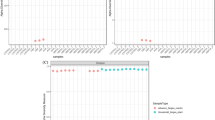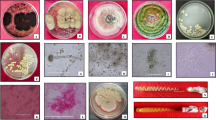Abstract
Metagenomics and transcriptomics have had some success analyzing community and functional ecology of the termite gut, but carbon utilization ecology and the effect of diet on the gut community are not well understood. This study was done to determine the effect of three hardwood tree types, oak (Quercus spp.), red maple (Acer rubrum), and tupelo (Nyssa aquatica) on the termite species, Reticulitermes flavipes in the family Rhinotermitidae. Termite abdomen homogenates were incubated on agar plates containing three common carbon sources in the termite gut, namely, acetate, cellobiose, and phenol under aerobic and anaerobic conditions. Bacterial growth was higher on cellobiose than any other carbon source. Higher bacterial growth on cellobiose was observed from termite colonies feeding on oak than on phenol from the other two wood types. The difference between aerobic and anaerobic conditions was not significant. A bacterium, Acinetobacter tandoii isolated and identified from our previous study was subjected to high concentrations of phenol as the sole carbon source and this bacterium was able to degrade phenol concentration up to 600 mg/L.





Similar content being viewed by others
References
Adams RP, McDaniel CA, Carter FL (1988) Termiticidal activities in the heartwood, bark/sapwood and leaves of Juniperus species from the United States. Biochem Syst Ecol 16:453–456
Anselmo AM, Novais JM (1984) Isolation and selection of phenol-degrading microorganisms from an industrial effluent. Biotech Lett 6:601–606
Beggs JD, Fewson CA (1977) Regulation and synthesis of benzyl alcohol dehydrogenase in Acinetobacter calcoaceticus NCIB8250. J Gen Microbiol 103:127–140
Behr EA, Behr CT, Wilson LF (1974) Influence of wood hardness on feeding by the eastern subterranean termite, Reticulitermes flavipes (Isoptera: Rhinotermitidae). Ann Entomol Soc Am 65:457–460
Boopathy R (1997) Anaerobic phenol degradation by microorganisms of swine manure. Curr Microbiol 35:64–67
Breznak J, Brune A (1994) Role of microorganisms in the digestion of lignocellulose by termites. Annu Rev Entomol 39:453–487
Brune A, Emerson D, Breznak JA (1995) The termite gut microflora as an oxygen sink: microelectrode determination of oxygen and pH gradients in guts of lower and higher termites. Appl Environ Microbiol 61:2681–2687
Brune A (1998) Termite guts: the world’s smallest bioreactors. Trends Biotechnol 16:16–21
Carr EL, Kämpfer P, Patel BKC, Gürtler V, Seviour RJ (2003) Seven novel species of Acinetobacter isolated from activated sludge. Int J Syst Evol Microbiol 53:953–963
Cleveland LR (1925) The ability of termites to live perhaps indefinitely on a diet of pure cellulose. Biol Bull 48:289–293
Doolittle M, Raina A, Lax A, Boopathy R (2007) Effect of natural products on gut microbes in Formosan subterranean termite, Coptotermes formosanus. Int Biodeterior Biodegradat 59:69–71
Doolittle M, Raina A, Lax A, Boopathy R (2008) Presence of nitrogen fixing Klebsiella pneumoniae in the gut of the Formosan subterranean termite (Coptotermes formosanus). Biores Technol 99:3297–3300
Genet M, Stokes A, Salin F, Mickovski SB, Fourcaud T, Dumail J-F, van Beek R (2005) The influence of cellulose content on tensile strength in tree roots. Plant Soil 278:1–9
Harazono K, Yamashita N, Shinzato N, Watanabe Y, Fukatsu T, Kurane R (2003) Isolation and characterization of aromatics-degrading microorganisms from the gut of the lower termite Coptotermes formosanus. Biosci Biotechnol Biochem 67:889–892
Hayashi A, Aoyagi H, Yoshimura T, Tanaka H (2007) Development of novel method for screening microorganisms using symbiotic association between insect (Coptotermes formosanus Shiraki) and intestinal microorganisms. J Biosci Bioeng 103:358–367
Judd TM, Corbin CC (2009) Effect of cellulose concentration on the feeding preferences of the termite Reticulitermes flavipes (Isoptera: Rhinotermitidae). Sociobiology. 5:775–784
Jung J, Park W (2015) Acinetobacter species as model microorganisms in environmental microbiology: current state and perspectives. Appl Microbiol Biotechnol 99:2533–2548
Kasseney BD, Deng T, Mo J (2011) Effect of wood hardness and secondary compounds on feeding preference of Odontotermes formosanus (Isoptera: Termitidae). Forest Entomol 104:862–867
Ke J, Sun J-Z, Nguyen HD, Singh D, Lee KC, Beyenal H, Chen S-L (2010) In-situ oxygen profiling and lignin modification in guts of wood-feeding termites. Insect Sci 17:277–290
Ke J, Singh D, Chen S (2011) Aromatic compound degradation by the wood-feeding termite Coptotermes formosanus (Shiraki). Int Biodeterior Biodegradation 65:744–756
Kuhnigk T, Borst E-M, Ritter A, Kämpfer P, Graf A, Hertel H, König H (1994) Degradation of lignin monomers by the hindgut flora of xylophagous insects. Syst Appl Microbiol 17:76–85
Lucey KS, Leadbetter JR (2014) Catechol 2,3-dioxygenase and other meta-cleavage catabolic pathway genes in the ‘anaerobic’ termite gut Spirochete Treponema primitia. Mol Ecol 23:1531–1543
Minnick DR, Wilkinson RC, Kerr SH (1973) Feeding preferences of the drywood termite, Cryptotermes brevis. Environ Entomol 2:481–484
Morales-Ramos JA, Rojas MG (2001) Nutritional ecology of the Formosan subterranean termite (Isoptera: Rhinotermitidae): feeding response to commercial wood species. J Econ Entomol 94:516–523
Nakashima K, Watanabe H, Saitoh H, Tokuda G, Azuma J-I (2002) Dual cellulose-digesting system of the wood-feeding termite, Coptotermes formosanus Shiraki. Insect Biochem Mol Biol 32:777–784
O’Brien RW, Breznak JA (1984) Enzymes of acetate and glucose metabolism in termites. Insect Biochem 14:639–643
Paisio CE, Talano MA, González PS, Magallanes-Noguera C, Kurina-Sanz M, Agostini E (2016) Biotechnological tools to improve bioremediation of phenol by Acinetobacter sp. RTE1.4. Environ Technol 37:2379–2390
Peralta RCG, Menezes EB, Carvalho AG, de Lima Aguiar-Menezes E (2004) Wood consumption rates of forest species by subterranean termites (Isoptera) under field conditions. Revista Árvore 28:283–289
Petterson RC (1984) The chemical composition of wood: the chemistry of solid wood. Adv Chem 207:57–126
Potrikus CJ, Breznak JA (1981) Gut bacteria recycle uric acid nitrogen in termites: a strategy for nutrient conservation. PNAS 78:4601–5605
Qureshi NA, Qureshi MZ, Ashraf A (2016) Comparative protozoacidal activities of different chemical extracts from various parts of three wood species against entozoic flagellates of Heterotermes indicola and Coptotermes heimi. Int J Biosci 8:53–62
Scheffrahn RH, Hsu R-C, Su N-Y, Huffman JB, Midland SL, Sims JJ (1988) Allelochemical resistance of bald cypress, Taxodium distichum, heartwood to the subterranean termite, Coptotermes formosanus. Journal of Chemical Ecology. 14:765–776
Sethi A, Slack JM, Kovaleva ES, Buchman GW, Scharf ME (2013) Lignin-associated metagene expression in a lignocellulose-digesting termite. Insect Biochem Mol Biol 43:91–101
Shahryari S, Zahiri HS, Haghbeen K, Adrian L, Noghabi KA (2018) High phenol degradation capacity of a newly characterized Acinetobacter sp. SA01: bacterial cell viability and membrane impairment in respect to phenol toxicity. Ecotoxicol Environ Saf 164:455–466
Slack JM (2012) Identification, production, and characterization of novel lignase proteins from termites for depolymerization of lignocellulose. OSTI, United States. Report number DOE/ER85063-1
Smith JA, Koehler PG (2007) Changes in Reticulitermes flavipes (Isoptera: Rhinotermitidae) gut xylanolytic activities in response to dietary xylan content. Ann Entomol Soc Am 100:568–573
Tanaka H, Aoyagi H, Shina S, Dodo Y, Yoshimura T, Nakamura R, Uchiyama H (2006) Influence of the diet components on the symbiotic microorganisms community in hindgut of Coptotermes fomosanus Shiraki. Appl Microbiol Biotechnol 71:907–917
Tartar A, Wheeler MM, Zhou X, Coy MR, Boucias DG, Scharf ME (2009) Parallel metatranscriptome analyses of host and symbiont gene expression in the gut of the termite Reticulitermes flavipes. Biotechnol Biofuels 2:25
Thayer DW (1978) Carboxymethylcellulase produced by facultative bacteria from the hindgut of the termite Reticulitermes hesperus. J Gen Microbiol 106:13–18
Thangaraj K, Kapley A, Purohit HJ (2008) Characterization of diverse Acinetobacter isolates for utilization of multiple aromatic compounds. Biores Technol 99:2488–2494
Van Dexter S, Boopathy R (2018) Biodegradation of phenol by Acinetobacter tandoii isolated from the gut of the termite. Environ Sci Pollut Res. https://doi.org/10.1007/s11356-018-3292-4
Watson SP, Clements MO, Foster SJ (1998) Characterization of the starvation-survival response of Staphylococcus aureus. J Bacteriol 180:1750–1758
Yamin M (1980) Cellulose metabolism by the termite flagellate Trichomitopsis termopsidis. Appl Environ Microbiol 39:859–863
Yamin M (1981) Cellulose metabolism by the flagellate Trichonympha from a termite is independent of endosymbiotic bacteria. Science 211:58–59
Yoshimura T, Fujino T, Itoh T, Tsunoda K, Takahashi M (1996) Ingestion and decomposition of wood and cellulose by the protozoa hindgut of Coptotermes formosanus Shiraki (Isoptera: Rhinotermitidae) as evidenced by polarizing and transmission electron microscopy. Holzforschung 50:99–104
Zhang D, Lax AR, Bland JM, Yu J, Fedorova N, Nierman WC (2010) Hydrolysis of filter-paper cellulose by two recombinant endogenous glycosyl hydrolases of Coptotermes formosanus. Insect Sci 17:245–252
Zheng H, Dietrich C, Radek R, Brune A (2016) Endomicrobium proavitum, the first isolate of Endomicrobia class. nov. (phylum Elusimicrobia)—an ultramicrobacterium with an unusual cell cycle that fixes nitrogen with a group IV nitrogenase. Environ Microbiol 18:191–204
Acknowledgements
This work was supported by the funds from the Louisiana Board of Regents and BP.
Author information
Authors and Affiliations
Corresponding author
Additional information
Publisher's Note
Springer Nature remains neutral with regard to jurisdictional claims in published maps and institutional affiliations.
Rights and permissions
About this article
Cite this article
Van Dexter, S., Oubre, C. & Boopathy, R. Carbon ecology of termite gut and phenol degradation by a bacterium isolated from the gut of termite. J Ind Microbiol Biotechnol 46, 1265–1271 (2019). https://doi.org/10.1007/s10295-019-02183-5
Received:
Accepted:
Published:
Issue Date:
DOI: https://doi.org/10.1007/s10295-019-02183-5




